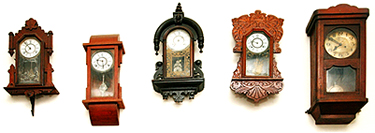"Know thy customer"I met the cheerful elderly man in the corridor of the London bound Virgin Pendolino train. He must have been close to 70, or maybe 70+ (I am not particularly good at guessing people's age). He had been advising another elderly lady on the perils of being trapped in train's disabled toilets - or worse, to suffer the embarassment of not having pushed the right button to lock the door. Seeing me - he shrugged his shoulders and expressed his inability to understand the 'ways' of the new world of laptops, shuffles, mice and sliding doors.

I could see his point perfectly - pushing a similar set of buttons to do dissimilar things didn't make sense to man who was used to closing a door with a handle (or knob) and locking with keys. Shapes communicated purpose - or function. In the electronic/digital world, it wasn't shapes - but symbols that communicated function. The buttons were all the same.
We both agreed it was to make the toilet 'accessible' to people who might not have the same ability as many of us to push, pull, twist etc. However - this set of buttons had made it inaccessible to some users. The law of Unintended Consequences. Would colours (the thick rings) have helped - stereotypes like red, amber and green?
He was however, genuinely surprised with one brand though. A brand called Saga. He called to renew his car insurance - when the voice answered his call, he fumbled for a number to press (maybe he hadn't heard the instructions: "press 1 for...") - he was reassured to hear an actual person at the end of the line. His insurance requests were actioned in less than the full 6 minutes.
Saga follows Prof. Porter's directive to the T - "stick to a niche". Saga serves the 50 year+ market and obviously knows what makes them tick. Saga itself has been around for well over 50 years and possibly is know better for its cruises/holidays for the age group. Apart from its holidays and insurance business, Saga also has a magazine, a search facility online to find old/new friends and a radio station. IA-Centre has an interesting
case study on the Saga105.2FM.

Like my fellow traveller in the corridor - Saga has possibly managed to delight thousands of other elderly customers in a world where marketing and advertising are increasingly youth oriented.
Saga's website has an over-emphasis on text - and may be fine for some of the 'readers' that scans the pages and reads it aloud to visually impaired. Though there is no indications or marks of its ccessibility credentials (those rows of neat logos at the bottom or a visible accessibility link on the home page itself). Very strangely, its home page and the second level looks distinctively different - I mean the buttons are different, the menu items on the left look different - almost everything apart from the colour. Saga's travelshop is different too and every possible pixel is covered by a rectangle of some size or a border - and I wonder what my fellow traveller would make of these.
Like the Pink PSP I wrote about earlier, Saga seems to have developed some new peripheral (and add-on) services/products for a niche market. However, like Dodge - their excellence in one area can be undermined by the lack of brand unity - in another area. The message for brand owners is simple - regular routine audits is the key (one of my former clients, Goldfish - was a master of this) as well as to avoid the temptation of adding too many features/buttons and links on their communication pieces. And of course - keeping in touch with what the customers think. Simple? Thats just the tip of the iceberg...
[Virgin train image courtsey Yappari.co.uk]
 Person of the Year: You
Person of the Year: You








